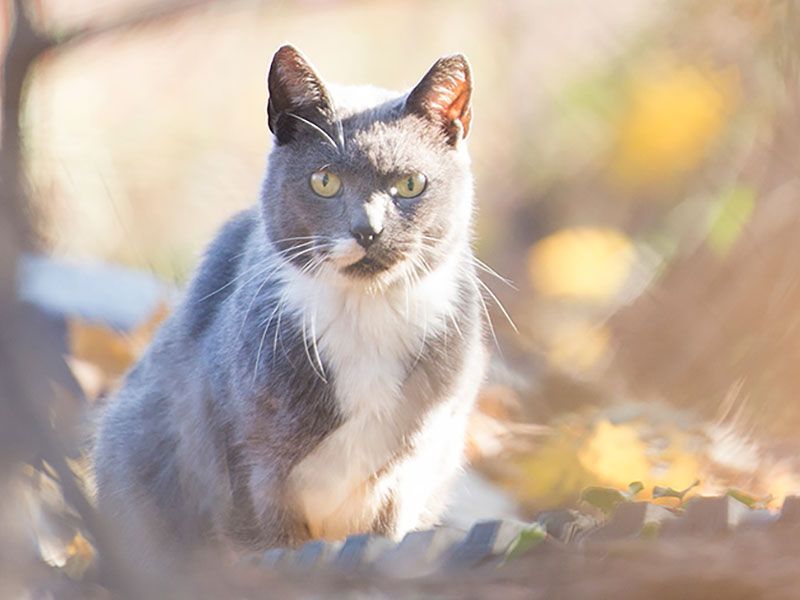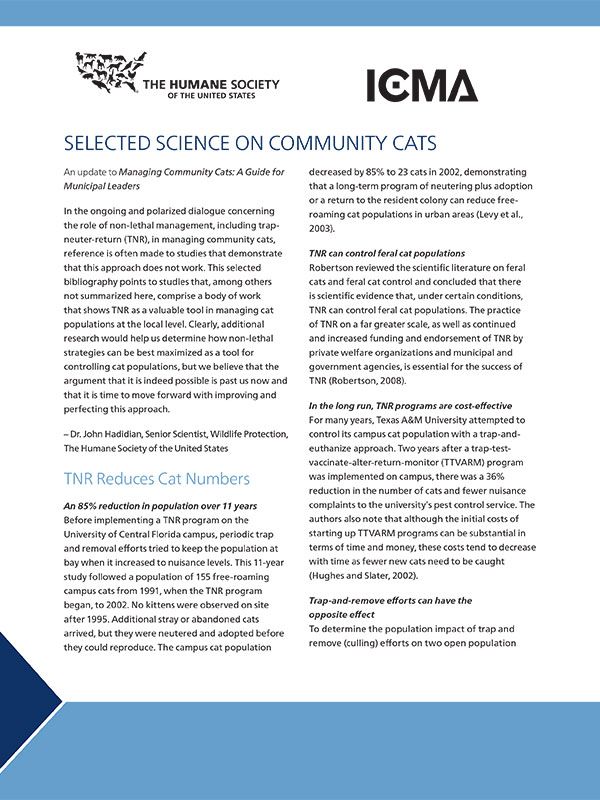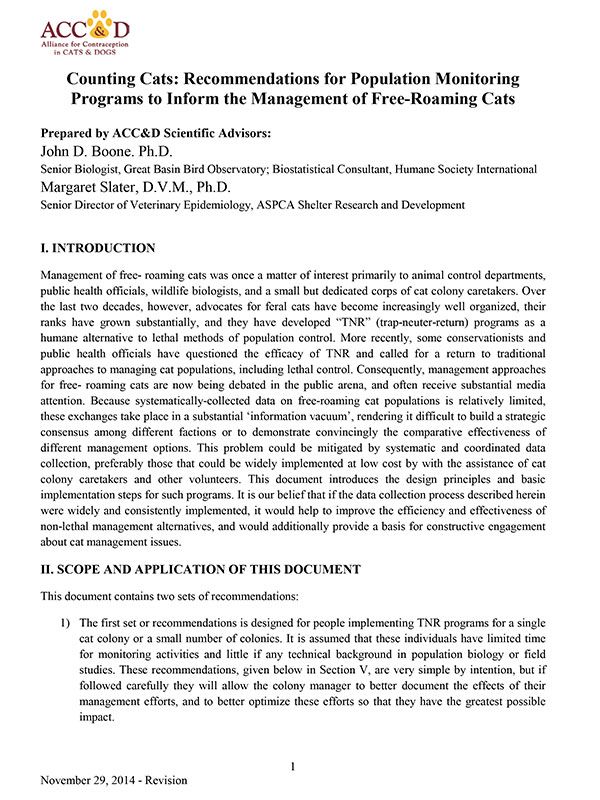Community cats: scientific studies and data
Current science shows trap/neuter/return (TNR) as a valuable tool in managing community cat populations at the local level

TNR works—there is no question. But the need for ongoing research to improve and perfect this emerging specialty within the animal welfare field is critical. In the ongoing and polarized dialogue concerning the impact cats have on wildlife, detractors often argue there is not enough scientific data to prove that TNR works. The HSUS is committed to demonstrating the efficacy of TNR and other non-lethal cat management programs, and we encourage all TNR practitioners to take part by documenting your success and working with experts to create reliable data showing your community as a success story.
This selected bibliography is a strong starting point to illustrate that targeted TNR is a valuable tool in managing cat populations at the local level.
Featured Studies
Combine RTF and targeted TNR for greater impact
A comprehensive community cat program, combining return to field and targeted TNR, demonstrated a greater impact on feline intake and euthanasia over ongoing community-based TNR efforts. This paper examines data from the Albuquerque Animal Welfare Department, a municipal shelter in New Mexico, over a three year period. In this time, feline euthanasia declined by 84.1%, intake dropped by 37.6% and the live release rate increased by 47.7%. Additionally, the shelter saw a modest increase in cats returned to their owners and feline adoptions as well as a fewer calls to the city about dead cats.
Spehar, D. D. and P. J. Wolf (2018). "The Impact of an Integrated Program of Return-to-Field and Targeted Trap-Neuter-Return on Feline Intake and Euthanasia at a Municipal Animal Shelter." Animals: an open access journal from MDPI 8(4): 55.
Targeted TNR resulted in 82% decline from peak population in neighborhood study
Citizen science was employed to document the impact of TNR in one Chicago neighborhood. Colony populations decreased by a mean of 82% from peak and 54% from when the colony was first recorded. Eight of the 20 colonies identified in the neighborhood were eliminated by the end of the study period.
Spehar, D. and P. Wolf (2018). "A Case Study in Citizen Science: The Effectiveness of a Trap-Neuter-Return Program in a Chicago Neighborhood." Animals 8(1): 14.
Additional Studies by Category
TNR Reduces Cat Numbers
TNR Reduces Nuisance Behaviors and Complaints
TNR, Adoption and Return-to-Field Programs Reduce Shelter Intake and Euthanasia
TNR’s Effects on Community Cats and Disease
Public Perceptions on Community Cats
Community Cats and Wildlife Predation
TNR Reduces Cat Numbers
Targeted TNR resulted in 82% decline from peak population in neighborhood study
Citizen science was employed to document the impact of TNR in one Chicago neighborhood. Colony populations decreased by a mean of 82% from peak and 54% from when the colony was first recorded. Eight of the 20 colonies identified in the neighborhood were eliminated by the end of the study period.
Spehar, D. and P. Wolf (2018). "A Case Study in Citizen Science: The Effectiveness of a Trap-Neuter-Return Program in a Chicago Neighborhood." Animals 8(1): 14.
100% reduction in 17 years
Newburyport Massachusetts implemented a trap-neuter-return program in 1992 which resulted in the elimination of more than 300 cats from the small town’s waterfront. Prior to starting TNR, then a new strategy, none of the colonies were managed. The last known cat on the waterfront died at age 16, 17 years after the TNR program began. The area has remained free of cats since that time. Examining retrospective data, this case study illuminates the effectiveness of comprehensive humane cat management efforts, yet points to the need for the establishment of standardized data collection and assessment practices.
Spehar, D. and P. Wolf (2017). "An Examination of an Iconic Trap-Neuter-Return Program: The Newburyport, Massachusetts Case Study." Animals 7(11): 81.
31% reduction in 2 years
This survey of Australians involved in trap-neuter-return found colony size decreased from 11.5 cats to 6.5 cats in 2. 2 years, a 31% reduction, through a combination of TNR and rehoming of social cats and kittens. Those surveyed reported a median of 69% of cats being sterilized. Cats were fed daily and provided prophylactic health care (primarily treatment for fleas and intestinal parasites). TNR is not widely practiced in Australia and illegal in many communities. Respondents participated in TNR as individuals more than in association with an organization and self-funded at least some of their work.
Tan, K., et al. (2017). "Trap-Neuter-Return Activities in Urban Stray Cat Colonies in Australia." Animals 7(6): 46.
An 85% reduction in population over 11 years
Before implementing a TNR program on the University of Central Florida campus, periodic trap and removal efforts tried to keep the population at bay when it increased to nuisance levels. This 11-year study followed a population of 155 free-roaming campus cats from 1991, when the TNR program began, to 2002. No kittens were observed on site after 1995. Additional stray or abandoned cats arrived, but they were neutered and adopted before they could reproduce. The campus cat population decreased by 85% to 23 cats in 2002, demonstrating that a long-term program of neutering plus adoption or a return to the resident colony can reduce freeroaming cat populations in urban areas (Levy et al., 2003).
Levy, J.K., Gale, D.W., and Gale, L.A. (2003). Evaluation of the effect of a long-term trap-neuter-return and adoption program on a free-roaming cat population. Journal of the American Veterinary Medical Association, 222,42-46.
TNR can control feral cat populations
Robertson reviewed the scientific literature on feral cats and feral cat control and concluded that there is scientific evidence that, under certain conditions, TNR can control feral cat populations. The practice of TNR on a far greater scale, as well as continued and increased funding and endorsement of TNR by private welfare organizations and municipal and government agencies, is essential for the success of TNR (Robertson, 2008).
Robertson, S.A. (2008). A review of feral cat control. Journal of Feline Medicine and Surgery, 10, 366-375.
In the long run, TNR programs are cost-effective
For many years, Texas A&M University attempted to control its campus cat population with a trap-andeuthanize approach. Two years after a trap-testvaccinate- alter-return-monitor (TTVARM) program was implemented on campus, there was a 36% reduction in the number of cats and fewer nuisance complaints to the university’s pest control service. The authors also note that although the initial costs of starting up TTVARM programs can be substantial in terms of time and money, these costs tend to decrease with time as fewer new cats need to be caught (Hughes and Slater, 2002).
Hughes, K.L. and Slater, M.R. (2002). Implementation of a feral cat management program on a university campus. Journal of Applied Animal Welfare Science, 5, 15-28.
Trap-and-remove efforts can have the opposite effect
To determine the population impact of trap and remove (culling) efforts on two open population sites in Tasmania, researchers used wildlife cameras and cat counts to track the number of cats at each site. Despite culling efforts, researchers found large increases in cat numbers: one site had a 75% increase, while another had a staggering 211% increase. Researchers suspect that the populations increased because new cats moved into the sites to take advantage of resources that became available when previously dominant cats were removed. Another explanation could be that kittens born to the unsterilized remaining cats had a better survival rate thanks to more readily available resources (Lazenby et al., 2014).
Lazenby, B.T., Mooney, N.J., and Dickman, C.R. (2014). Effects of low-level culling of feral cats in open populations: a case study from the forests of southern Tasmania. Wildlife Research, 41, 401-420.
TNR Reduces Nuisance Behaviors and Complaints
Neutered free-roaming males exhibit less aggression
This study compared four free-roaming cat colonies in urban Israel: two that were managed by TNR and two that were not managed at all. Less aggression was observed in the neutered groups, specifically between males, which resulted in reduced fighting and vocalizations. The study concludes that TNR reduced the noise associated with mating and fighting and could lead to fewer nuisance complaints (Finkler et al., 2011).
Finkler H, Gunther I, and Terkel J. “Behavioral differences between urban feeding groups of neutered and sexually intact free-roaming cats following a trap-neuter-return procedure.” Journal of the American Veterinary Medical Association 238, no. 9 (2011); 1141–1149.
Reduced nuisance behaviors in reality and perception
Researchers at a federal facility and hospital in Louisiana studied 41 cats in a TNR program. Three years later, 30 of the original cats remained. Their overall health had improved and nighttime vocalizations were greatly reduced, and no new litters of kittens were found. Although cats were seen as a nuisance prior to the program, human attitudes changed by the end of the three-year period (Zaunbrecher and Smith, 1993).
Zaunbrecher, K.I. and Smith, R.E. (1993). Neutering of feral cats as an alternative to eradication programs. Journal of the American Veterinary Medical Association, 203, 449-452.
TNR, Adoption and Return-to-Field Programs Reduce Shelter Intake and Euthanasia
Combine RTF and targeted TNR for greater impact
A comprehensive community cat program, combining return to field and targeted TNR, demonstrated a greater impact on feline intake and euthanasia over ongoing community-based TNR efforts. This paper examines data from the Albuquerque Animal Welfare Department, a municipal shelter in New Mexico, over a three year period. In this time, feline euthanasia declined by 84.1%, intake dropped by 37.6% and the live release rate increased by 47.7%. Additionally, the shelter saw a modest increase in cats returned to their owners and feline adoptions as well as a fewer calls to the city about dead cats.
Spehar, D. D. and P. J. Wolf (2018). "The Impact of an Integrated Program of Return-to-Field and Targeted Trap-Neuter-Return on Feline Intake and Euthanasia at a Municipal Animal Shelter." Animals: an open access journal from MDPI 8(4): 55.
Decreased intake helps expand capacity to care for other cats
An evaluation of 8 years of data from San Jose Animal Care and Control compared intake and health before and after the implementation of a Return to Field (Shelter Neuter Return) program. Initiation of the program was associated with a decreased number of cats admitted to the shelter and a lower proportion euthanized. With increased resources to care for cats with URI and changes in the URI treatment protocol, fewer cats were euthanized for URI and more cats were treated at lower cost and with a briefer shelter stay.
Edinboro, C, Watson, H, Fairbrother, A. (2016) “Association between a shelter-neuter-return program and cat health at a large municipal animal shelter.” Journal of the American Veterinary Medical Association 248, no.3:298-308.
Dramatically reduced shelter intake, impound and euthanasia numbers
This study examined the impact of a municipal shelter’s Return to Field program in San Jose, California. These programs are shelter-based and include sterilizing, vaccinating, ear tipping and returning healthy, impounded community cats to the place they were found, with or without an identified caregiver. Over four years, the shelter’s program garnered decreases in cat intakes (from 70% to 23%), cat and kitten impounds (by 29.1%) and euthanasia for Upper Respiratory Disease (by 99%) (Johnson and Cicirelli, 2014).
Johnson, K.L. and Cicirelli, J. (2014). Study of the effect on shelter cat intakes and euthanasia from a shelter neuter return project of 10,080 cats from March 2010 to June 2014. PeerJ, 2:e646, http://dx.doi.org/10.7717/peerj.646.
Significant reductions in shelter intake and euthanasia numbers
A two-year program in Alachua County, Florida, was implemented to capture and neuter at least 50% of the estimated community cats in a single zip code. If the cats were friendly, they were adopted out. If not, they were returned to the area. Researchers then compared trends in shelter cat intake from the target zip code to those of the rest of the county. After two years, per capita shelter intake was 3.5 times higher and per capita shelter euthanasia was 17.5 times higher in the nontarget area than in the target area. Clearly, high-impact targeted TNR combined with the adoption of socialized cats and nuisance resolution counseling for residents is an effective tool for reducing shelter cat intake (Levy et al., 2014).
Levy, J.K., Isaza, N.M., and Scott, K.C. (2014). Effect of high-impact targeted trap-neuter-return and adoption of community cats on cat intake to a shelter. The Veterinary Journal, 201, 269-274.
TNR’s Effects on Community Cats and Disease
Check out the Cats and public health page to learn more about common public health concerns.
Cat ownership in early childhood not an indicator of psychotic episodes
Some previous studies have suggested a link of some sort between childhood Toxoplasma gondii infection and schizophrenia later in life. Some researchers have gone so far as to suggest a link with early childhood cat-ownership, but evidence is limited. This study looked at British data to see whether the presence of a household cat during pregnancy or early childhood was associated with an increased prevalence of psychotic episodes in early and late adolescence. Researchers found no such link and concluded that cat ownership during pregnancy or early childhood does not confer an increased risk of psychotic episodes in late adolescence.
Solmi, F., et al. (2017). Curiosity killed the cat: no evidence of an association between cat ownership and psychotic symptoms at ages 13 and 18 years in a UK general population cohort. Psychological Medicine, 1-9.
New Zealand population shows no link between Toxoplasmosis infection and mental health issues
Studies showing correlative links between Toxoplasma gondii infection and potential increases in schizophrenia, suicide attempts and poor impulse control have often been conducted on small clinical or convenience samples, rather than large populations. This study utilized data and participants in a population-representative birth cohort of adults enrolled in the Dunedin Longitudinal Study (New Zealand). Approximately 28% of the population tested positive for T. gondii infection. Various impulse control, cognitive indicators and other tests of mental health were performed. Results indicated no increased risk of aberrant mental conditions associated with T. gondii infection.
Sugden, K., et al. (2016). Is Toxoplasma Gondii Infection Related to Brain and Behavior Impairments in Humans? Evidence from a Population-Representative Birth Cohort. PLoS ONE 11(2): e0148435.
Including vaccinations in TNR programs can protect feral cats for many years
A TNR program for feral cats in Florida included vaccinations at the time of sterilization. Researchers were able to compare a cat’s antibody titers (a measurement that indicates the strength of the body’s immune response to a given disease) before the vaccinations and then 10 weeks post-vaccination. Many cats had an excellent immune response, indicated by the increase in protective antibody titers post-vaccination: panleukopenia (90%), herpes (56%), calicivirus (93%) and rabies (98%). Other studies have shown that postvaccination immunity persists for a minimum of three to seven years in most cats, which means that many feral cats are protected for much of their remaining lifespan. The authors conclude that TNR programs that include vaccinations are likely to protect individual cats and possibly reduce diseases in feral cats in general (Fischer et al., 2007).
Fischer S.M., Quest C.M., Dubovi E.J., Davis R.D., Tucker S.J., Friary J.A., Crawford P.C., Ricke T.A. and Levy J.K. Response of feral cats to vaccination at the time of neutering. Journal of the American Veterinary Medical Association 2007; 230(1): 52–8.
Unowned free-roaming cats don’t have higher FeLV infection rates than owned cats
In this study, 1,876 unowned free-roaming cats who were treated in TNR programs in North Carolina and Florida were tested for FeLV infection and FIV antibodies. The results indicate that the prevalence of FeLV infection and FIV antibodies in unowned freeroaming cats are similar to infection rates reported for owned cats (Lee et al., 2002).
Lee, I.T., Levy, J.K., Gorman, S.P., Crawford, P.C. and Slater, M.R. Prevalence of feline leukemia virus infection and serum antibodies against feline immunodeficiency virus in un-owned free-roaming cats. Journal of the American Veterinary Medical Association, 2002; 220: 620–622.
The secondary effects of neutering can improve community cat welfare
Body condition scores can help evaluate a cat’s overall health and welfare. This study analyzed the body condition of 105 adult feral cats at the time of neutering and found that they were lean (but not emaciated). Fourteen of the original cats were trapped one year later and showed significant increases in weight and improvements in body condition similar to those of confined pet cats. Caretakers also noted that neutered cats roamed less. The researchers conclude that in addition to halting reproduction, neutering may have other effects that improve the welfare of community cats (Scott et al., 2002).
Scott, Karen C., Julie K. Levy, and Shawn P. Gorman, “Body Condition of Feral Cats and the Effect of Neutering.” Journal of Applied Animal Welfare Science 5, no. 3 (2002); 203–213.
Despite popular belief, toxoplasmosis is not definitively associated with exposure to cats
According to the authors, the transmission of toxoplasmosis from cats to people rarely occurs from direct contact. They state that people most commonly acquire toxoplasmosis by eating the cyst form of toxoplasmosis in undercooked meat. A case study of toxoplasmosis in pregnant women did not show a significant association with having an adult cat or kitten at home, cleaning the litter box or having a cat who actively hunts. The authors also cite a study of HIVinfected adults that did not show any association of toxoplasmosis with cat ownership or exposure (Kravetz and Federman, 2002).
Kravetz, J.D. and Federman, D.G. Cat-associated zoonoses. Archives of Internal Medicine, 162(17), 1945-1952.
Public Perceptions
Support for TNR is strong regardless of urban, rural or suburban lifestyles.
This study looked at attitudes about free-roaming cats among individuals living in urban, suburban and rural Ohio. Utilizing a representative telephone survey of residents 18 and older, Lord was able to show differences in attitude and perception based on whether the individual owned a cat or not, and the type of residential area they lived in. Of those surveyed, close to 60% owned at least one pet overall, and just over 30% owned at least one cat. Rural residents were significantly more likely to have unsterilized owned cats, and to let their cats roam outdoors than the suburban and urban survey respondents. 28.9% of overall respondents reported seeing free-roaming cats (other than their own) in their neighborhood on a daily basis. Of the participants who reported seeing free-roaming cats, 33.3% reported having fed cats at least once in the past year. Lord also found that very few respondents had any awareness of local laws or regulations that impact cats (12.7%) versus fairly high awareness of laws impacting dogs (67.3%). The awareness of any locally offered trap/neuter/return (TNR) programs was equally low with only 11.2% of respondents aware of a program. However, most respondents agreed with the statement that TNR programs are a good way to manage free-roaming cats (74.1% either agreed or strongly agreed).
Lord, Linda K. (2008). Attitudes toward and perceptions of free-roaming cats among individuals living in Ohio. J Am Vet Med Assoc, 232, 1159-1167.
American adults favor the non-lethal treatment of community cats
Adults in a national survey conducted by Harris Interactive were given two options: leave a community cat as-is or catch and kill the cat. More than four out of five people thought it was more humane to leave the cat. The survey then added a twist: what if the community cat would die two years later after being hit by a car? More than 70% of respondents still chose to let the cat remain in the community. The authors conclude that an overwhelming majority of Americans believe that leaving a stray cat outside to live out his life is more humane than having him caught and killed (Chu and Anderson, 2007).
Chu, K. and Anderson, W.M. (2007). Public Opinion on Humane Treatment of Stray Cats. (Law & Policy Brief). Bethesda, MD: Alley Cat Allies. Retrieved from http://www.alleycat.org/page.aspx?pid=357.
Wildlife management practices should be based on shared opinions
Conflicts over cat management practices often prevent or delay the implementation of policies that could reduce cat populations, improve animal welfare and reduce risks to wildlife. This study reveals the differences of opinion that lead to these conflicts, specifically among Audubon members, the public and TNR program participants. They also note areas of agreement among the groups and suggest that stakeholders focus on these shared opinions when developing policies. For example, mandatory pet identification, rabies vaccination and non-lethal methods of management could satisfy all groups (Wald et al., 2013).
Wald, D.M., Jacobson, S.K., and Levy J.K. (2013). Outdoor cats: identifying differences between stakeholder beliefs, perceived impacts, risk and management. Biological Conservation, 167, 414–424.
Wildlife Predation
Cats rare in protected areas with coyotes
With more than 2000 sample sites across 6 Mid-Atlantic States, researchers concluded that free-roaming cats were relatively rare in protected areas where coyotes were prevalent. They detected no cats in 50% of the protected areas while 44% had just one. More than one cat was detected in only two of the 32 study areas. Researchers also found that the relative abundance of free-roaming cats was 300 times higher in residential yards, where coyotes were rare, than in the protected areas.
Kays, R., et al. (2015). Cats are rare where coyotes roam. Journal of Mammalogy 96(5): 981-987.
Bright colors can reduce predation rates of owned cats allowed outdoors
This Australian study looked at predation rates among owned cats over a two-year period when wearing the Birdbesafe collar cover. This cover slips over a standard collar and relies on bright colors to warn prey, especially birds, with good color-vision. The study relied on owner-reported data of prey brought home, so may under-report actual predation activity. Invertebrate prey were also not tracked in this study. In the first year of study red, yellow and rainbow-colored collars were tested. 53 cats from 39 households completed the study. Multiple cats from one household were combined since many owners could not determine which cat had caught the prey. Cats were randomly assigned to the color collars and tracked for 3-week periods with the collar on and with it off. First year data indicated that the rainbow collar was the most effective in reducing prey caught. The second year of study focused on just the rainbow collar, with 61 new cats from 43 new households enrolled. Overall, when wearing the Birdbesafe collar, rates of identified predation reduced by a total of 37%. When considering only prey with good color vision (birds and reptiles/amphibians) the reduction was 54%. The majority of owners reported that the cats quickly acclimated to the new collar within a couple days.
Hall, C, Fontaine, J, Bryant, K, Calver, M. (2015) Assessing the effectiveness of the Birdsbesafe®anti-predation collar cover in reducing predation on wildlife by pet cats in Western Australia.. Applied Animal Behaviour Science 173:40-51.
Opposing parties should compromise on cat management approaches
The authors suggest ways that conflicts between cat colony caretakers and bird conservation professionals can be managed more productively. For example, bird conservation professionals’ values could guide cat colony management in high conservation priority areas, whereas cat colony caretaker values could guide management in low conservation priority areas. The authors conclude that bird conservation professionals must develop innovative and collaborative ways to address threats posed by feral cats instead of advocating for euthanasia in all situations (Peterson et al., 2012).
Peterson M.N., Hartis B., Rodriguez S., Green M. and Lepczyk C.A. (2012). Opinions from the front lines of cat colony management conflict. PLoS ONE, 7:e44616.. doi:10.1371/journal.pone.0044616.
Current methods of measuring predation rates could be inaccurate
This study found that many cat owners overestimate their cats’ predation rates. The authors conclude that surveying predation rates with questionnaires alone isn’t sufficient since the self-reported numbers aren’t always accurate. They note that further extended studies are needed, especially in large urbanized areas with varied habitat types, cat densities and prey availability. The authors recommend using the “what the cats brought home” method at a larger scale in time and space. At a larger scale, this method would more accurately assess the seasonal variation in predation rates, individual hunting behavior throughout the year and the actual impact of cat predation on prey populations (Tschanz et al., 2011).
Tschanz, B., Hegglin, D., Gloor, S. and Bontadina F. (2011). Hunters and non-hunters: skewed predation rate by domestic cats in a rural village. European Journal of Wildlife Research, 57, 597-602.
Related Documents
Documents






